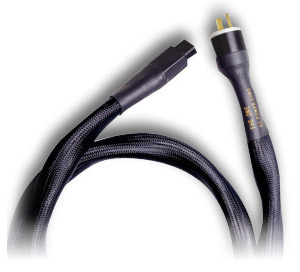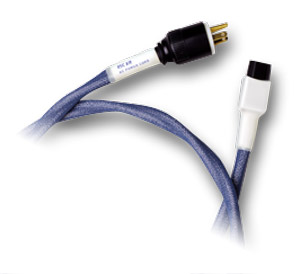![[SoundStage!]](../titles/sslogo3.gif) Home
Audio Home
Audio Equipment Review |
|||||||||||||||||
November 2001 TARA Labs The One and RSC Air Power Cordsby Marc Mickelson
In my review of the TARA Labs Air 1 interconnects and speaker cables from May 2000, I told of my past experience with TARA Labs products. What I omitted from the discussion was my use of the TARA Labs Affinity, the first after-market power cord I experimented with. I used the Affinity on various preamps and amps, and I easily heard its contribution -- a blacker background and lessening of electronic grunge. The Affinity cords were dirt cheap by today's standards -- I think I paid $300 for a pair of them brand new -- but not when I bought them, a time when power cords were considered the tweakiest of tweaks. Both TARA Labs and I have moved on since our Affinity days, both of us to sundry other, and more costly, power cords. The One and Air RSC under examination here, $1195 USD and $695 respectively, were introduced at CEDIA 2000 and follow on the heels of similar TARA Labs designs that use the company's Rectangular Solid Core conductors, which TARA Labs claims "is the only conductor that is able to combine high current-carrying capability with extreme frequency linearity across the musical spectrum." This is due to the conductor's non-round shape, which is said to minimize skin effect -- the tendency with round conductors for higher frequencies to travel toward the outside of the conductor. How this kind of conductor translates for use in power cords, as opposed to signal-carrying cables, is less understandable to me, but TARA Labs uses RSC conductors for both The One and RSC Air power cords. In the case of The One, 36 RSC conductors are helixed around a Teflon air tube and separated into 12AWG live and neutral paths. Each run is isolated within a primary Airtube, a TARA Labs feature, and separately shielded. The Aero-PE dielectric material is special too -- it "reacts less with the signal in the conductor, making it more sonically neutral than other materials." The One is clad in black outer mesh and is rather thick and heavy -- it may tip a light component to which it's connected. The RSC Air power cord is identical except that there are only 24 RSC conductors to approximate 14AWG runs, they are inside Airtubes and not helixed around one, there is no Aero-PE dielectric, and the cord is covered in a sky-blue outer mesh that's particularly attractive. In my system Before inserting the TARA Labs power cords into my reference system, I burned them in for over 100 hours each. No, I didn't do this while having the power cords in my audio system. Instead, I used some special IEC-to-outlet adapters from Shunyata Research, into which I plugged a pair of lamps. It's unglamorous work, but it has to be done.
I used the power cords, three of each, on my Lamm ML2 monoblocks and L2 Reference preamp, Bel Canto DAC1.1, Mark Levinson No.39 CD player, and a Wilson Audio WATCH Dog subwoofer. The cords were plugged into an array of power-line products, including a Shunyata Hydra, PS Audio P300 with MultiWave, Richard Gray's Power Company 400S, and ESP Power Distributor. In the case of the P300, I used an RSC Air power cord from it to my hospital-grade wall socket. Speakers were Wilson Audio WATT/Puppy 6 or Sophia; interconnects and speaker cables were from TARA Labs (Air One), Nordost (Quattro-Fil and SPM Reference), Acoustic Zen (Silver Reference and Hologram), and JPS Labs (Superconductor2 and NC Series). I also used at various points a Mark Levinson No.383 integrated amp. Power cords for comparison were from Shunyata Research, ESP, and JPS Labs. If that's not everything, it should be! Power and sound The game of these TARA Labs power cords is one of contrasts -- dynamic and especially between the signal and the noise below it -- as well as tonal richness. The One is more accomplished in these regards than the RSC Air cord, but it's fairly obvious that both are from the same company. I used a pair of The One cords on my Lamm amps, with a third on my Lamm preamp. I did the same with a trio of RSC Air cords, and then used all six of the TARA Labs cords sent to me to power my entire system. Over the past few months I've been buying some great DCC remasters from a music store at an outlet mall near me. The store, Music for a Song, has a website from which you can order at the in-store prices, and shipping is only $1.89 per order. Prices range from $5.99 to $14.99, with a vast bulk of the discs priced at $9.99. At any of these prices, the discs are far below their cost elsewhere, which hovers around $25. With the TARA Labs cords in my system, Sonny Rollins' tone on The Sound of Sonny [DCC GZS-1092] is full and gutsy on "Mangoes", and the inner detailing of the drum work is readily apparent due to the very quiet background from which the music emerges. The same occurs on "Will You Still Be Mine?" from The Musings of Miles [DCC GZS-1106]. Miles Davis' is wonderfully controlled, but he punctuates with short bursts of spittiness, and the cymbals and piano are "tinkly" but perfectly delineated from each other. As my notes say, both recordings "sound thoroughly modern" even though they are from the '50s, which is certainly a testament to Steve Hoffman's remastering prowess. These recordings also highlight a trait that The One and RSC Air share with TARA Labs interconnects and speaker cables: soundstage integrity, a wholeness of the sound produced. Some listeners poo-poo soundstaging, but for me it's vital to suspending disbelief, and I've found no other cables that equal TARA Labs products in this regard. The tonally saturated presentation of these TARA Labs power cords is saved from being a troublesome coloration by the way the cords also enhance dynamic contrasts both large and small. The various Telarc recordings I have around here are almost all warmish to begin with, but I particularly enjoyed the discs I have from the Jacques Loussier Trio while I had the TARA Labs power cords in my system. Satie [Telarc CD-83431] and Baroque Favorites [Telarc CD-83516] are the two I've been listening to habitually over the past few months, and their inherent warmth is no more noticeable with the TARA Labs The One or RSC Air in use because of the soaring dynamics of the music as well as the more subtle shadings. "Grossienne No.6" from the Satie disc is hypnotic because of a repeated phrase throughout, but it's the power and subtlety of the recording that keeps its sound from turning syrupy. If you have a subwoofer, you'll hear it while you play any of the Jacques Loussier Trio recordings on Telarc, and if your system is highly resolving, you'll be startled at times with the beauty of the sound. These recordings will remind you why you're into high-end audio to begin with. In general, potential buyers of The One and RSC Air power cords are more solid-state aficionados than tubeheads, as these power cords will add some richness to sterile solid-state sound but also enhance the drive and dynamics that buyers of solid-electronics often crave. Both worked so well with the Mark Levinson No.383 that they should be included in the box. My tube-heavy system offers high resolution and musicality, and these cords worked very well in it. But if your system lacks incisiveness or is overly laid-back, these power cords won't be for you, although your problems almost certainly have more to do with your choice of equipment than power cord. Comparisons The power cords that I've been using most often are those from Shunyata Research, whose Hydra has become a necessary part of my audio system. I compared the Shunyata PowerSnakes Black Mamba and Viper V2 to the TARA Labs cords, and the results were somewhat surprising. The Black Mamba in particular matched the overall character of the TARA Labs cords very closely. All have a darker, more lush presentation that is significant because of the small-scale dynamic prowess as well as the lowering of noise. The One was by far the best of the three with amplifiers, seemingly increasing power and/or current delivery. I liked the Black Mamba and RSC Air cords best with digital components, especially the Perpetual Technologies P-1A. The Viper V2 was a contrast from all three cords, however. Its sound was more neutral, and more prominent in the upper frequencies. It sounds more detailed, but it lacks the tonal ease of the TARA Labs cords and even the Black Mamba. It's more straightforward and up front, and while I liked it very much with my Lamm amps, its sound didn't mesh as well with the Mark Levinson No.383 integrated amp, perhaps because of its more linear nature. Among the things to consider when building an audio system is overall balance, and your choice of power cords should go a long way toward fulfilling this. In my system, the Viper V2 or The One were the choices with my Lamm amps, The One with my Lamm preamp, and the Black Mamba and RSC Air with digital gear. This achieved the best balance of tonal richness with overall incisiveness, resolution with sweetness, and honesty to the original signal (if we can even discern this) with involvement. Still The One While some audiophiles don't hear the need for add-on power cords, I can easily hear differences among the ones I've listened to over the years, proving to me that they do have some kind of effect at the very least. I continue to get e-mail asking about matches with certain pieces of equipment as well expressing that "Your hearing is @#$%^$." Our policy at SoundStage! is to report the results of what we hear first, and I know what I'm hearing from the various power cords I've used in my system. These TARA Labs cords have some definite characteristics, including tonal richness along with the ability to sort out and convey dynamic contrasts well. Add to these the perceived lowering of background noise, and you have a product that's at least worth a try before you dismiss it. I especially liked The One with my Lamm amps and preamp, their strengths meshing well with the electronics and my personal tastes. The RSC Air power cord may well be ideal for use with digital gear. Whether you are a power-cord skeptic or believer, giving a listen to these TARA Labs cords will give you more fodder for your beliefs. I know I enjoyed my time with them. ...Marc Mickelson
|
|||||||||||||||||
|
|||||||||||||||||
![[SoundStage!]](../titles/sslogo3.gif) All
Contents All
ContentsCopyright © 2001 SoundStage! All Rights Reserved |

